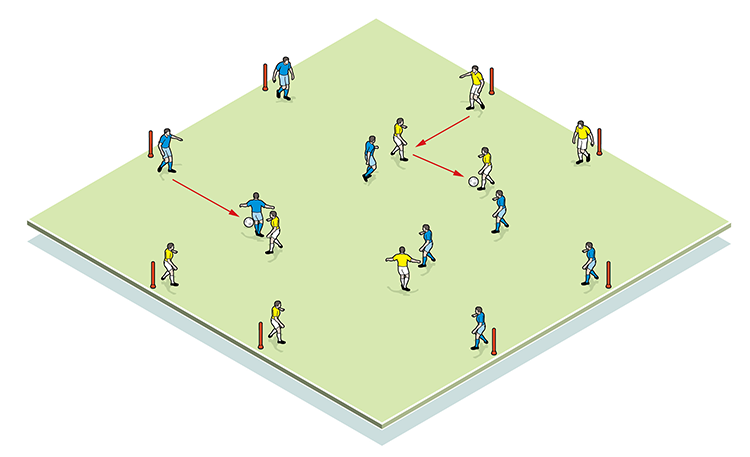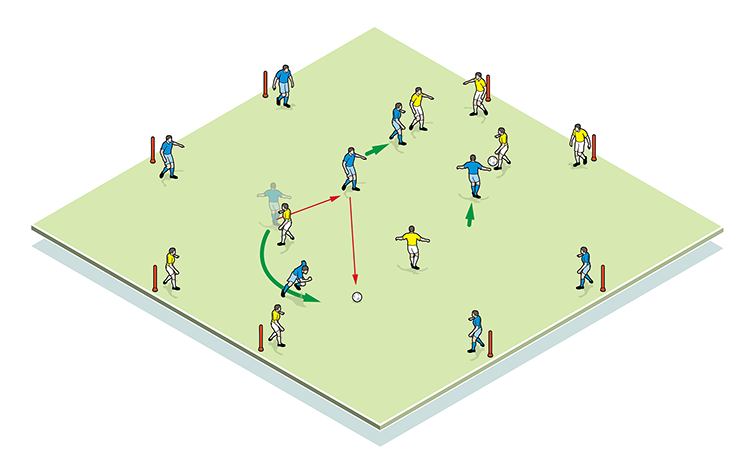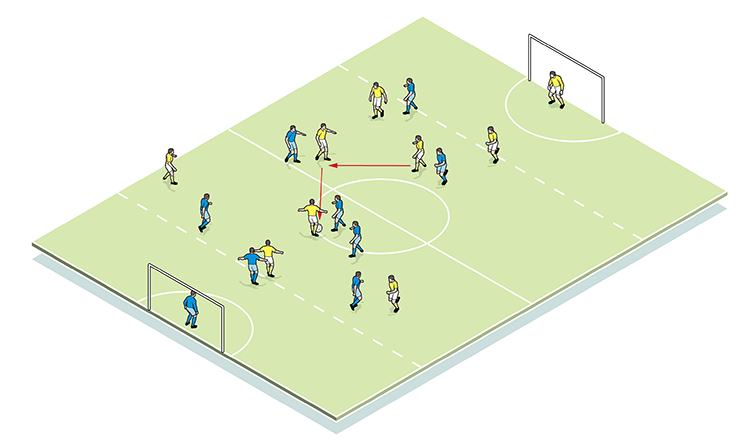




OUR BEST EVER OFFER - SAVE £100/$100
JOIN THE WORLD'S LEADING PROFESSIONAL DEVELOPMENT PROGRAMME
- 12 months membership of Elite Soccer
- Print copy of Elite Player & Coach Development
- Print copy of The Training Ground
You are viewing 1 of your 1 free articles
Positivity and awareness
| Area | Game One: 30x30 yards Game Two: The area in between penalty boxes |
| Equipment | Cones or poles, balls, goals |
| No. of Players | 18 |
This session teaches players to stay positive and aware in game situations, with a focus on moving play forward at all times. It encourages players to think about what’s ahead of and around them and relies on a good first touch and the use of clever angled passes.
In the Premier League, the better the players we face, the less time we have to make correct decisions, so rehearsing this session improves players’ offensive mindset, which is important not only in creating chances, but in terms of ball retention as well.
What do I get the players to do?
We play each of the small-sided games below for 20 minutes.
Game One: Cross-passing goals
Having placed two poles on opposite sides of the playing area 10 yards in from the corners, we stand a blue player on each. On the remaining two sides are poles with yellow players on so that, in total, four players from each team occupy fixed positions on poles. One ‘pole player’ from each team starts with a ball.
In the central playing area is a two-ball 4v4 battle. Players must receive the ball from their team-mate on a pole and thread passes through to one of the two players on the opposite edge. A point is scored for each ball that makes it across.
Attacking is only one part though, as players need to respect their defensive duties. They must be ready to switch direction, in doing so combining attacking build-up play with a defensive strategy that stifles the opposition. If they break up an opposition attack, they can score by feeding the ball to one of their own fixed players.
1

2

3

Game Two: Playing forward
In this game we place goals on the 18-yard lines and play in the space between the two penalty boxes, with a 15-yard zone in front of each goal. This is again played 8v8.
We play a small-sided game whereby the ball must go forward until it reaches the 15-yard zone. This is the only area in which it can be passed backwards. If it goes back anywhere else, possession is given to the other team’s keeper.
Attacking players must always display positive forward movements and a willingness to break into space.
Both this and the Cross-passing game can be progressed by limiting play to one or two touches, or by insisting that the ball remains on the ground.
1

2

3

What are the key things to look out for tactically/technically?
In game one, players need to be side-on to play. We are looking for attacking desire, with players displaying an urgency to defend and break up the play that is coming towards them at a 90 degree angle. Players must keep their body open and never end up with their backs to play.
In game two, excellent body shape and strong decision making is essential in order to keep the ball moving forward.
Related Files
Editor's Picks
Attacking transitions
Deep runs in the final third
Using the goalkeeper in build-up play
Intensive boxes drill with goals
Penetrating the final third
Creating and finishing
My philosophy
Pressing initiation
Compact team movement
Coaches' Testimonials

Alan Pardew

Arsène Wenger

Brendan Rodgers

Carlos Carvalhal

José Mourinho

Jürgen Klopp

Pep Guardiola

Roy Hodgson

Sir Alex Ferguson

Steven Gerrard
Coaches' Testimonials

Gerald Kearney, Downtown Las Vegas Soccer Club

Paul Butler, Florida, USA

Rick Shields, Springboro, USA

Tony Green, Pierrefonds Titans, Quebec, Canada
Join the world's leading coaches and managers and discover for yourself one of the best kept secrets in coaching. No other training tool on the planet is written or read by the calibre of names you’ll find in Elite Soccer.
In a recent survey 92% of subscribers said Elite Soccer makes them more confident, 89% said it makes them a more effective coach and 91% said it makes them more inspired.
Get Monthly Inspiration
All the latest techniques and approaches
Since 2010 Elite Soccer has given subscribers exclusive insight into the training ground practices of the world’s best coaches. Published in partnership with the League Managers Association we have unparalleled access to the leading lights in the English leagues, as well as a host of international managers.
Elite Soccer exclusively features sessions written by the coaches themselves. There are no observed sessions and no sessions “in the style of”, just first-hand advice delivered direct to you from the coach.







